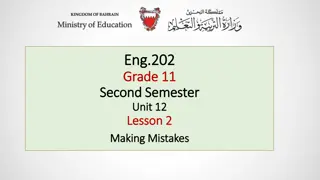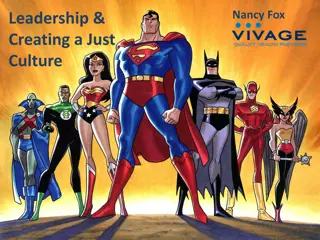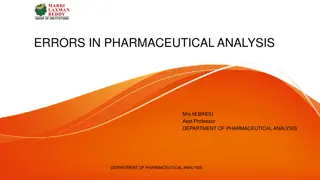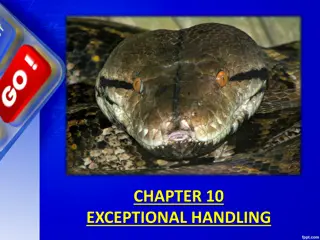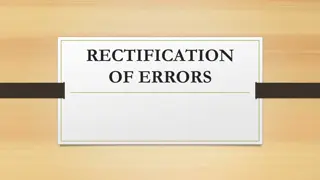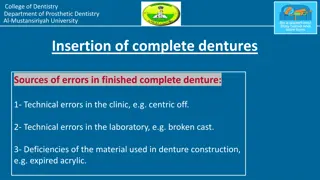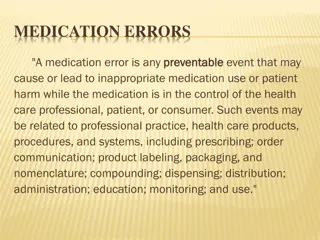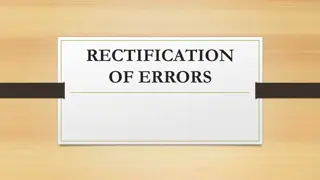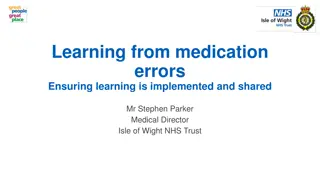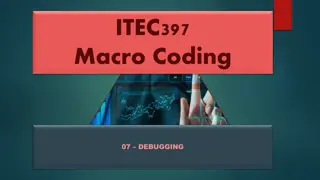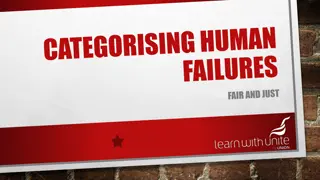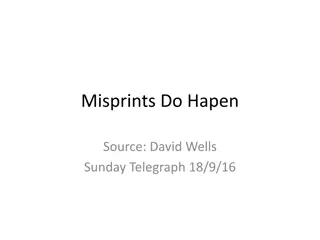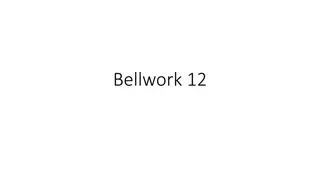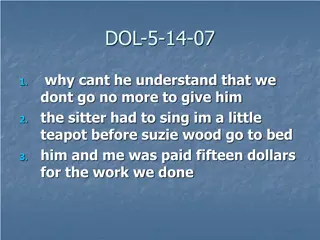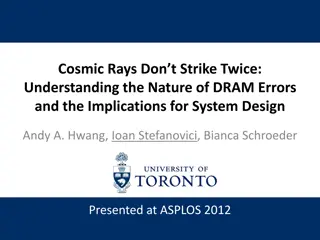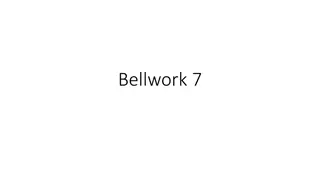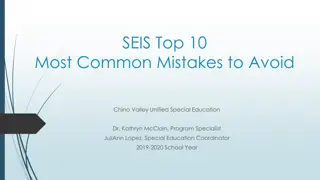Identifying Student Learning Errors and Mistakes in Education
When examining student work, it's crucial to consider individual learning styles to differentiate between learning errors and simple mistakes. Identifying these errors helps determine students' progress accurately. Additionally, understanding the root cause, whether behavioral or emotional, is essential for effective intervention and support. This process goes beyond just assessing grades or scores, focusing on specific errors to guide future instruction and support student needs.
- Student learning errors
- Education
- Differentiated instruction
- Behavioral and emotional needs
- Effective intervention
Download Presentation

Please find below an Image/Link to download the presentation.
The content on the website is provided AS IS for your information and personal use only. It may not be sold, licensed, or shared on other websites without obtaining consent from the author. Download presentation by click this link. If you encounter any issues during the download, it is possible that the publisher has removed the file from their server.
E N D
Presentation Transcript
PLC Student Learning: Part 1 Identify Student Learning Errors For Granite School District Educators 10-1 Identify Student Learning Errors Title Slide.mp3
IDENTIFY the types, frequencies, and distribution of learning, learning errors, language errors, and mistakes evident in student work in relation to our instructional and classroom management practices. How will we know that our students are learning? What, if any, Learning Errors, Language Errors, or Mistakes evident? 10-3 PLC Student Learning Section of Model.mp3
Before committing to a particular course of action or investing time in developing possible solutions, it is important that you fully understand the learner-centered problem, which we define as a problem of understanding or skill [behavioral and social emotional trauma] that underlies students performance on assessments. -Boudett, City, and Murnane, 2005; Data Wise: A Step-by-Step Guide to Using Assessment Results to Improve Teaching and Learning 10-4 Before Commiting to a Course of Action.mp3
Summary: Identifying Student Learning Errors When looking at student work samples, it is crucial to consider the individual students and their unique learning styles. By knowing your students and their abilities, you can determine between actual learning errors or simple mistakes more easily. It is important to identify and distinguish between learning errors or mistakes to see where all of the students fall. This process is different than looking at student scores or grades (1, 2, 3, or 4). Within each score there could be multiple learning errors that may occur, making it essential to sort based on learning errors and mistakes, to truly identify where students are and how to best move forward. Another factor to consider is that the learning error may stem from behavioral and social or emotional needs. Are they dealing with trauma and therefore not learning, or thinking clearly? Is this directly leading to the learning error? 10-5 Summary Idenitfying Student Learning Errors.mp3
What is a Student Learning Error? A student learning error occurs when the student doesn't understand the system of thought that allows for application of the content or vocabulary that is being learned. In other words, a student learning error is what they are stuck on or where their thinking is held up. This line of thinking is inhibiting learning to take place and move forward. Examples of Learning Errors 3,002+ 29 = ABC The main character in the Three Little Pigs is blue. When adding and subtracting fractions, a student is multiplying the denominators together (to find a common denominator), but then adds the numerators together, forgetting the rule that whatever you do to the bottom you have to do to the top. 10-6 What is a Student Learning Error.mp3
What is a Mistake? A mistake is different than a student learning error. A mistake is when students understand the system of thought and its application but they just didn't do the computation right in math, mentioned a wrong character, read the directions incorrectly, etc. Once the mistake is pointed out, the student is able to fix it without help. Carelessness is one type of mistake. Examples of Mistakes 3,006 + 2,109 = 5,105 The main character in the Three Little Pigs is the Mom Pig. When doing division, the student is rushing through, the process is sound, however the student misses simple subtraction resulting in the wrong answer. 10-7 What is a Mistake.mp3
What Kind of Student Work and Student Learning Error Causes do we Look At? Some questions that might help guide what to look at are: What student work do we look at? How do we look at it? What kind of errors are being made? Is it a learning error or mistake? Why did the student miss the concept? What is the cause -- could it be a behavioral, emotional, or rooted in trauma? 10-8 What Kind of Student Work.mp3
Types of Learning Errors Incomplete Understanding: Students have a partial understanding. They haven t learned it wrong; they just haven t learned it yet. Examples: Student puts a period after every word OR On the diagram of the nervous system, the student leaves several parts blank. Flaws in Reasoning: Students carry out the pattern of reasoning with one or more missteps. Examples: A student includes extraneous details when writing a summary OR A student generalizes a statement that is true for the evidence presented but does not extend to other instances. Misconceptions: Students have internalized a concept of an explanation of a phenomenon that they believe to be true but that does not match current best thinking. Examples: A student states that night and day are a result of the sun going up and down OR a student argues that the Mississippi River is the longest river in the U.S. 10-9 Types of Learning Errors.mp3 Source: Lucariello, J. & Naff, D. How Do I Get My Students Over their Alternative Conceptions (Misconceptions) for Learning? https://www.apa.org/education/k12/misconceptions
Behavioral and Social Emotional Needs as a Root Cause of Learning Errors If behavioral and social emotional needs are the cause of the learning error, how do we analyze student trauma or social emotional learning, to help them become engaged in the classroom? This GSD website will help with some ideas:https://granitedistrictpbis.weebly.com/ Secondary teachers may find it helpful to meet with other teachers across content areas to discuss individual students and strategize how to address that student s learning errors and best meet their social-emotional needs. 10-10 Behavioral and Social Emotional Needs.mp3
Discussing Student Errors and Mistakes in the PLC As your PLC team determines and discusses the learning errors you see in your students work, categorize and strategize the common learning errors you see as a team. This is a more effective approach than merely counting the amount of proficient vs. non-proficient students. Once the learning errors and mistakes are recognized and discussed, teams can then utilize the support of one another to group their students based on each learning error. By doing this, PLCs can hold targeted discussions for each group in how to reteach for the given learning error or extend for the groups that have mastered the initial content. With this approach, student small groups will be fluid, and change week to week or even day to day. Teachers will be aware of specific students abilities as they fluctuate between concepts and skills. 10-11 Discussing Student Errors and Mistakes in the PLC.mp3
Coming Prepared for This Step in the Student Learning PLC In order to have an effective PLC looking at student learning, you need to have first gathered data. While any student achievement data can be analyzed, CFA data is often the most helpful for PLC work as it is clearly connected to instruction and common to the grade and content. It is important to have CFAs graded and learning errors examined prior to this meeting in order to utilize the time together most effectively. It is also important to have considered some behavior and social emotional root causes as well. Be prepared in your PLC to discuss the learning errors that you have seen. Being prepared to discuss specific students, errors and strategies will allow for more ideas, supports, creativity and collaboration during your PLC time. 10-12 Coming Prepared for This Step.mp3
District Tools That Support our Inferences There are some district tools that are available to help support your ability to infer meaning from your assessments, district assessments, and behavioral causes: School City WIDA DIBELS Educators Handbook The inferences about academics or behavior that you make will help you create meaningful interventions and extensions for your students. 10-13 FIXED District Tools that Support our Inferences.mp3
Continue to StrategizeHow to Respond to Student Learning



